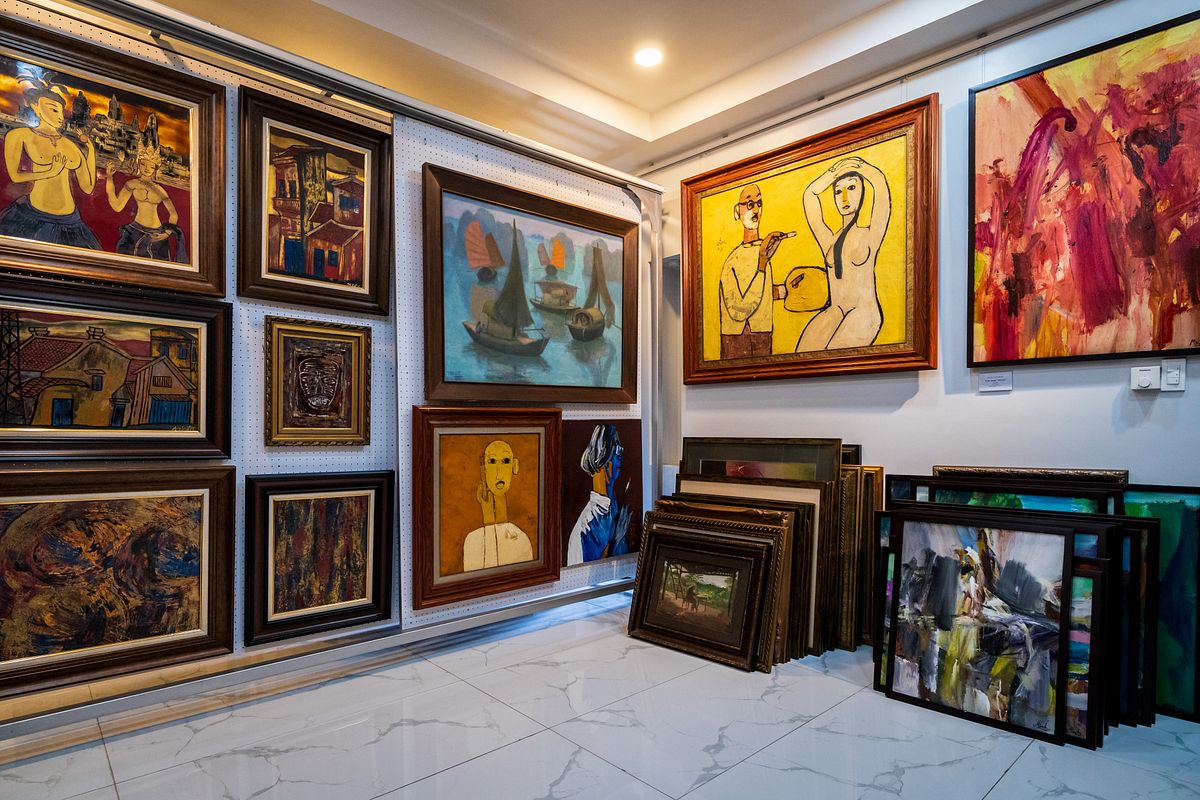TASK 2 (AGREE OR DISAGREE): LOCAL ARTWORKS
Many people think that museums and galleries should only show work from local artists rather than work from other countries. Do you agree?
Sample Answer
There has been a considerable debate as to whether cultural institutions, such as museums and galleries, should exclusively display local artworks at the expense of internationally sourced or globally curated art masterpieces. I disagree with this proposal on the grounds of cultural inclusivity and visitors’ appeal, despite tangible benefits to the local community.
Proponents of exclusively curating works of art from the immediate locality argue in favour of the preservation of local cultural heritage. These advocates maintain that this method of curation can help maintain and carry forth long-standing local values, such as deeply ingrained traditions, customs, and folklores, while preventing, to some degree, undesirable cultural assimilation that may lead to cultural erosion. Salient examples include the Titanic Museum in Southampton or the Sherlock Holmes Museum on Baker Street, London, both of which only display carefully selected and meticulously curated exhibits that strictly follow their respective themes. A secondary reason in favour of this proposal is that this display exclusivity would rekindle the interest of locals, who tend to be largely indifferent to local cultural institutes when compared with tourists. The War Remnants Museum in Ho Chi Minh City, Vietnam, for example, prioritises artefacts and monuments particularly relevant to the community, resulting in increased attendance and greater levels of appeal in recent years.
However, showcasing cultural works from local artists on an exclusive basis can risk overlooking inclusivity and undermining global attendance. Detractors of exclusive curation argue that local culture may not be fully understood and appreciated without being properly placed within a global context. This can be evidenced in the case study of the Museum of London, which took the initiative to include artefacts, memorabilia, and artworks from other European nations and the United States of America during World War II in an effort to elucidate what transpired when viewed from the perspective of the British Royal Family and the UK administration led by Winston Churchill. It is undeniable that when observing cultural works from an isolated and disentangled context, one may develop misperceptions and unfair prejudices towards a certain party, leading to biased judgements. Furthermore, when museums and galleries house internationally curated artworks alongside regionally sourced exhibits, this is likely to capture greater attention from locals, who then have stronger motives to visit their cultural venues that are often frequented by tourists. A salient example is Buckingham Palace in London, which now incorporates other globally sourced artworks, resulting in increased visitor attendance.
In conclusion, while collecting exclusively local artworks can ostensibly result in local cultural preservation and a rekindled interest from the locals, these benefits are largely theoretical and not grounded in concrete facts. However, an approach emphasising inclusivity can broaden the horizons of museumgoers, leading to increased knowledge about both local and global heritage while sustainably maintaining high local attendance, rendering it a preferred choice.
Marking by Chat GPT 5
TỪ VỰNG HAY
Many people think that museums and galleries should only show work from local artists rather than work from other countries. Do you agree?
There has been a considerable debate as to whether cultural institutions, such as museums and galleries, should exclusively display local artworks at the expense of internationally sourced or globally curated art masterpieces. I disagree with this proposal on the grounds of cultural inclusivity and visitors’ appeal, despite tangible benefits to the local community.
Proponents of exclusively curating works of art from the immediate locality argue in favour of the preservation of local cultural heritage. These advocates maintain that this method of curation can help maintain and carry forth long-standing local values, such as deeply ingrained traditions, customs, and folklores, while preventing, to some degree, undesirable cultural assimilation that may lead to cultural erosion. Salient examples include the Titanic Museum in Southampton or the Sherlock Holmes Museum on Baker Street, London, both of which only display carefully selected and meticulously curated exhibits that strictly follow their respective themes. A secondary reason in favour of this proposal is that this display exclusivity would rekindle the interest of locals, who tend to be largely indifferent to local cultural institutes when compared with tourists. The War Remnants Museum in Ho Chi Minh City, Vietnam, for example, prioritises artefacts and monuments particularly relevant to the community, resulting in increased attendance and greater levels of appeal in recent years.
However, showcasing cultural works from local artists on an exclusive basis can risk overlooking inclusivity and undermining global attendance. Detractors of exclusive curation argue that local culture may not be fully understood and appreciated without being properly placed within a global context. This can be evidenced in the case study of the Museum of London, which took the initiative to include artefacts, memorabilia, and artworks from other European nations and the United States of America during World War II in an effort to elucidate what transpired when viewed from the perspective of the British Royal Family and the UK administration led by Winston Churchill. It is undeniable that when observing cultural works from an isolated and disentangled context, one may develop misperceptions and unfair prejudices, leading to biased judgements. Furthermore, when museums and galleries house internationally curated artworks alongside regionally sourced exhibits, this is likely to capture greater attention from locals, who then have stronger motives to visit their cultural venues that are often frequented by tourists. A salient example is Buckingham Palace, which now incorporates other globally sourced artworks, resulting in increased visitor attendance.
In conclusion, while collecting exclusively local artworks can ostensibly result in local cultural preservation and a rekindled interest from the locals, these benefits are largely theoretical and not grounded in concrete facts. However, an approach emphasising inclusivity can broaden the horizons of museumgoers, leading to increased knowledge about both local and global heritage while sustainably maintaining high local attendance, rendering it a preferred choice.
Vocabulary
- considerable debate – cuộc tranh luận đáng kể
- cultural institutions – các tổ chức văn hoá
- exclusively display local artworks – chỉ trưng bày tác phẩm nghệ thuật địa phương
- internationally sourced – có nguồn gốc quốc tế
- globally curated art masterpieces – kiệt tác nghệ thuật được tuyển chọn toàn cầu
- on the grounds of cultural inclusivity – vì lý do bao dung văn hoá
- tangible benefits – lợi ích hữu hình
- in favour of the preservation of local cultural heritage – ủng hộ việc bảo tồn di sản văn hoá địa phương
- method of curation – phương pháp trưng bày/giám tuyển
- carry forth long-standing local values – duy trì và phát huy giá trị địa phương lâu đời
- deeply ingrained traditions – truyền thống ăn sâu bén rễ
- cultural assimilation – sự hoà nhập văn hoá
- cultural erosion – sự mai một văn hoá
- salient examples include – ví dụ điển hình bao gồm
- carefully selected and meticulously curated exhibits – hiện vật được chọn lọc và trưng bày tỉ mỉ
- rekindle the interest of locals – khơi lại sự quan tâm của người dân địa phương
- indifferent to local cultural institutes – thờ ơ với các tổ chức văn hoá địa phương
- undermining global attendance – làm suy giảm lượng khách quốc tế
- within a global context – trong bối cảnh toàn cầu
- elucidate what transpired – làm sáng tỏ điều đã xảy ra
- isolated and disentangled context – bối cảnh tách biệt, rời rạc
- misperceptions and unfair prejudices – nhận thức sai lầm và định kiến bất công
- house internationally curated artworks alongside regionally sourced exhibits – trưng bày song song tác phẩm quốc tế và địa phương
- broaden the horizons of museumgoers – mở rộng tầm hiểu biết của khách tham quan bảo tàng
- rendering it a preferred choice – khiến nó trở thành lựa chọn được ưa chuộng
✔ DÀN Ý
1️. Introduction – Mở bài
- Có considerable debate whether museums should only show local artworks or include globally curated pieces.
- → I disagree ❌ because of cultural inclusivity and visitors’ appeal.
🧩 Cấu trúc: “There has been debate about whether… I disagree because…”
2️. Body 1 – Ủng hộ local art (nhưng mình không chọn)
- Supporters want to preserve local cultural heritage 🏺.
- Giúp carry forth long-standing local values & tránh cultural erosion.
- Examples: Titanic Museum, Sherlock Holmes Museum → carefully curated exhibits.
- Display exclusivity may rekindle locals’ interest.
🧩 Cấu trúc: “Proponents argue that… This helps preserve… For example…”
3️. Body 2 – Quan điểm của mình (phản đối độc quyền)
- Chỉ trưng bày local art có thể overlook inclusivity & undermine global attendance.
- Detractors argue that culture needs a global context to be fully understood.
- Example: Museum of London → included foreign artefacts to elucidate what transpired.
- Broader curation → capture greater attention from locals & tourists alike.
🧩 Cấu trúc: “However, showcasing only local works can… Critics argue that… For instance…”
4️. Conclusion – Kết luận
- While local art aids preservation, it’s theoretical only.
- Inclusive approach → broaden horizons, maintain attendance, → preferred choice ✅
🧩 Cấu trúc: “While … can…, an inclusive approach can…, making it a preferred choice.”


